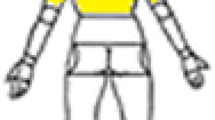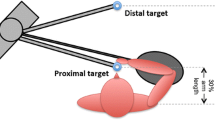Abstract
Purpose
The aim of this study was to compare the stiffness of the dorsal scapular muscles before and after computer work between individuals with and without neck and shoulder complaints.
Methods
Thirty subjects were divided into patient (n = 18) and control (n = 12) groups. The stiffness of the upper trapezius, levator scapulae, and rhomboid major was measured using ultrasound elastography before and after a 30-min typing task. The strain ratio of the muscle to an acoustic coupler was calculated (a lower strain ratio value indicates greater muscle stiffness).
Results
At baseline, the strain ratio of the upper trapezius in the patient group (3.762 ± 1.679) (mean ± SD) was significantly lower than that of the control group (7.763 ± 5.921) (p = 0.041). No significant change in the strain ratio of the upper trapezius after the typing task was observed in the patient group (4.158 ± 3.465) (p = 0.549). A significant decrease in the strain ratio of the levator scapulae after the typing task was observed in the patient group (before: 9.006 ± 7.079, after: 5.718 ± 2.847) (p = 0.022), whereas there was no significant change in the control group (p = 0.436).
Conclusions
The increase in stiffness of the upper trapezius is an objective finding and may be a persistently altered condition in individuals with neck and shoulder complaints. The patterns of change in stiffness of the levator scapulae are different between individuals with and without neck and shoulder complaints.



Similar content being viewed by others
Abbreviations
- ANOVA:
-
Analysis of variance
- ARFI:
-
Acoustic radiation force impulse
- BMI:
-
Body mass index
- EMG:
-
Electromyographic
- ICC:
-
Intraclass correlation coefficient
- MRE:
-
Magnetic resonance elastography
- ROI:
-
Region of interest
- RTE:
-
Real-time tissue elastography
- SD:
-
Standard deviation
- VAS:
-
Visual analog scale
References
Akagi R, Kusama S (2015) Comparison between neck and shoulder stiffness determined by shear wave ultrasound elastography and a muscle hardness meter. Ultrasound Med Biol 41:2266–2271. doi:10.1016/j.ultrasmedbio.2015.04.001
Andersen H, Ge HY, Arendt-Nielsen L, Danneskiold-Samsoe B, Graven-Nielsen T (2010) Increased trapezius pain sensitivity is not associated with increased tissue hardness. J Pain 11:491–499. doi:10.1016/j.jpain.2009.09.017
Andersen LL, Hansen K, Mortensen OS, Zebis MK (2011) Prevalence and anatomical location of muscle tenderness in adults with nonspecific neck/shoulder pain. BMC Musculoskelet Disord 12:169. doi:10.1186/1471-2474-12-169
Ashina M, Bendtsen L, Jensen R, Sakai F, Olesen J (1999) Muscle hardness in patients with chronic tension-type headache: relation to actual headache state. Pain 79:201–205
Bot SDM (2005) Incidence and prevalence of complaints of the neck and upper extremity in general practice. Ann Rheum Dis 64:118–123. doi:10.1136/ard.2003.019349
Boyle JJ, Milne N, Singer KP (2002) Influence of age on cervicothoracic spinal curvature: an ex vivo radiographic survey. Clin Biomech (Bristrol, Avon) 17:361–367
Cagnie B, Dhooge F, Van Akeleyen J, Cools A, Cambier D, Danneels L (2012) Changes in microcirculation of the trapezius muscle during a prolonged computer task. Eur J Appl Physiol 112:3305–3312. doi:10.1007/s00421-012-2322-z
Chen Q, Bensamoun S, Basford JR, Thompson JM, An KN (2007) Identification and quantification of myofascial taut bands with magnetic resonance elastography. Arch Phys Med Rehabil 88:1658–1661. doi:10.1016/j.apmr.2007.07.020
Chen Q, Wang HJ, Gay RE, Thompson JM, Manduca A, An KN, Ehman RE, Basford JR (2016) Quantification of myofascial taut bands. Arch Phys Med Rehabil 97:67–73. doi:10.1016/j.apmr.2015.09.019
Chino K, Akagi R, Dohi M, Fukashiro S, Takahashi H (2012) Reliability and validity of quantifying absolute muscle hardness using ultrasound elastography. PLoS One 7:e45764. doi:10.1371/journal.pone.0045764
Cote P, Cassidy JD, Carroll LJ, Kristman V (2004) The annual incidence and course of neck pain in the general population: a population-based cohort study. Pain 112:267–273. doi:10.1016/j.pain.2004.09.004
Dyrehag LE, Widerstrom-Noga EG, Carlsson SG, Kaberger K, Hedner N, Mannheimer C, Andersson SA (1998) Relations between self-rated musculoskeletal symptoms and signs and psychological distress in chronic neck and shoulder pain. Scand J Rehabil Med 30:235–242
Holtermann A, Sogaard K, Christensen H, Dahl B, Blangsted AK (2008) The influence of biofeedback training on trapezius activity and rest during occupational computer work: a randomized controlled trial. Eur J Appl Physiol 104:983–989. doi:10.1007/s00421-008-0853-0
Horikawa M (2001) Effect of visual display terminal height on the trapezius muscle hardness: quantitative evaluation by a newly developed muscle hardness meter. Appl Ergon 32:473–478
Ishikawa H, Muraki T, Sekiguchi Y, Ishijima T, Morise S, Yamamoto N, Itoi E, Izumi S (2015) Noninvasive assessment of the activity of the shoulder girdle muscles using ultrasound real-time tissue elastography. J Electromyogr Kinesiol 25:723–730. doi:10.1016/j.jelekin.2015.07.010
Johansson H, Sojka P (1991) Pathophysiological mechanisms involved in genesis and spread of muscular tension in occupational muscle pain and in chronic musculoskeletal pain syndromes: a hypothesis. Med Hypotheses 35:196–203
Johansson H, Sjolander P, Djupsjobacka M, Bergenheim M, Pedersen J (1999) Pathophysiological mechanisms behind work-related muscle pain syndromes. Am J Ind Med Suppl 1:104–106
Juul-Kristensen B, Kadefors R, Hansen K, Bystrom P, Sandsjo L, Sjogaard G (2006) Clinical signs and physical function in neck and upper extremities among elderly female computer users: the NEW study. Eur J Appl Physiol 96:136–145. doi:10.1007/s00421-004-1220-4
Kaergaard A, Andersen JH, Rasmussen K, Mikkelsen S (2000) Identification of neck-shoulder disorders in a 1 year follow-up study. Validation Of a questionnaire-based method. Pain 86:305–310
Kendall FP, McCreary EK, Provance PG (1993) Muscles, testing and function: with posture and pain, 4th edn. Williams and Wilkins, Baltimore
Kuo WH, Jian DW, Wang TG, Wang YC (2013) Neck muscle stiffness quantified by sonoelastography is correlated with body mass index and chronic neck pain symptoms. Ultrasound Med Biol 39:1356–1361. doi:10.1016/j.ultrasmedbio.2012.11.015
Kuorinka I, Jonsson B, Kilbom A, Vinterberg H, Biering-Sorensen F, Andersson G, Jorgensen K (1987) Standardised Nordic questionnaires for the analysis of musculoskeletal symptoms. Appl Ergon 18:233–237
Larsson B, Sogaard K, Rosendal L (2007) Work related neck-shoulder pain: a review on magnitude, risk factors, biochemical characteristics, clinical picture and preventive interventions. Best Pract Res Clin Rheumatol 21:447–463. doi:10.1016/j.berh.2007.02.015
Ma C, Szeto GP, Yan T, Wu S, Lin C, Li L (2011) Comparing biofeedback with active exercise and passive treatment for the management of work-related neck and shoulder pain: a randomized controlled trial. Arch Phys Med Rehabil 92:849–858. doi:10.1016/j.apmr.2010.12.037
Muraki T, Ishikawa H, Morise S, Yamamoto N, Sano H, Itoi E, Izumi S (2015) Ultrasound elastography-based assessment of the elasticity of the supraspinatus muscle and tendon during muscle contraction. J Shoulder Elbow Surg 24:120–126. doi:10.1016/j.jse.2014.04.012
Murayama M, Nosaka K, Yoneda T, Minamitani K (2000) Changes in hardness of the human elbow flexor muscles after eccentric exercise. Eur J Appl Physiol 82:361–367. doi:10.1007/s004210000242
Nakamura M, Nishiwaki Y, Ushida T, Toyama Y (2011) Prevalence and characteristics of chronic musculoskeletal pain in Japan. J Orthop Sci 16:424–432. doi:10.1007/s00776-011-0102-y
Oldfield RC (1971) The assessment and analysis of handedness: the Edinburgh inventory. Neuropsychologia 9:97–113
Raine S, Twomey LT (1997) Head and shoulder posture variations in 160 asymptomatic women and men. Arch Phys Med Rehabil 78:1215–1223
Ranasinghe P, Perera YS, Lamabadusuriya DA, Kulatunga S, Jayawardana N, Rajapakse S, Katulanda P (2011) Work related complaints of neck, shoulder and arm among computer office workers: a cross-sectional evaluation of prevalence and risk factors in a developing country. Environ Health 10:70. doi:10.1186/1476-069x-10-70
Rosendal L, Larsson B, Kristiansen J, Peolsson M, Sogaard K, Kjaer M, Sorensen J, Gerdle B (2004) Increase in muscle nociceptive substances and anaerobic metabolism in patients with trapezius myalgia: microdialysis in rest and during exercise. Pain 112:324–334. doi:10.1016/j.pain.2004.09.017
Sikdar S, Shah JP, Gebreab T, Yen RH, Gilliams E, Danoff J, Gerber LH (2009) Novel applications of ultrasound technology to visualize and characterize myofascial trigger points and surrounding soft tissue. Arch Phys Med Rehabil 90:1829–1838. doi:10.1016/j.apmr.2009.04.015
Silva AG, Punt TD, Sharples P, Vilas-Boas JP, Johnson MI (2009) Head posture and neck pain of chronic nontraumatic origin: a comparison between patients and pain-free persons. Arch Phys Med Rehabil 90:669–674. doi:10.1016/j.apmr.2008.10.018
Simons DG (2004) Review of enigmatic MTrPs as a common cause of enigmatic musculoskeletal pain and dysfunction. J Electromyogr Kinesiol 14:95–107. doi:10.1016/j.jelekin.2003.09.018
Sjogaard G, Rosendal L, Kristiansen J, Blangsted AK, Skotte J, Larsson B, Gerdle B, Saltin B, Sogaard K (2010) Muscle oxygenation and glycolysis in females with trapezius myalgia during stress and repetitive work using microdialysis and NIRS. Eur J Appl Physiol 108:657–669. doi:10.1007/s00421-009-1268-2
Szeto GP, Straker LM, O’Sullivan PB (2005a) A comparison of symptomatic and asymptomatic office workers performing monotonous keyboard work-1: neck and shoulder muscle recruitment patterns. Man Ther 10:270–280. doi:10.1016/j.math.2005.01.004
Szeto GP, Straker LM, O’Sullivan PB (2005b) A comparison of symptomatic and asymptomatic office workers performing monotonous keyboard work-2: neck and shoulder kinematics. Man Ther 10:281–291. doi:10.1016/j.math.2005.01.005
Takasaki H, Delbridge BM, Johnston V (2015) Taping across the upper trapezius muscle reduces activity during a standardized typing task—an assessor-blinded randomized cross-over study. J Electromyogr Kinesiol 25:115–120. doi:10.1016/j.jelekin.2014.10.004
Visser B, van Dieen JH (2006) Pathophysiology of upper extremity muscle disorders. J Electromyogr Kinesiol 16:1–16. doi:10.1016/j.jelekin.2005.06.005
Yanagisawa O, Niitsu M, Kurihara T, Fukubayashi T (2011) Evaluation of human muscle hardness after dynamic exercise with ultrasound real-time tissue elastography: a feasibility study. Clin Radiol 66:815–819. doi:10.1016/j.crad.2011.03.012
Yip CH, Chiu TT, Poon AT (2008) The relationship between head posture and severity and disability of patients with neck pain. Man Ther 13:148–154. doi:10.1016/j.math.2006.11.002
Acknowledgements
We are deeply grateful to staff of Hitachi Aloka Medical Japan for skillful technical assistance. We had no financial support for the present study.
Author information
Authors and Affiliations
Corresponding author
Ethics declarations
Conflict of interest
The authors declare that they have no conflict of interest.
Ethical approval
All procedures performed in studies involving human participants were in accordance with the ethical standards of the institutional and/or national research committee and with the 1964 Helsinki declaration and its later amendments or comparable ethical standards.
Informed consent
Informed consent was obtained from all individual participants included in the study.
Additional information
Communicated by Benedicte Schepens.
Rights and permissions
About this article
Cite this article
Ishikawa, H., Muraki, T., Morise, S. et al. Changes in stiffness of the dorsal scapular muscles before and after computer work: a comparison between individuals with and without neck and shoulder complaints. Eur J Appl Physiol 117, 179–187 (2017). https://doi.org/10.1007/s00421-016-3510-z
Received:
Accepted:
Published:
Issue Date:
DOI: https://doi.org/10.1007/s00421-016-3510-z




